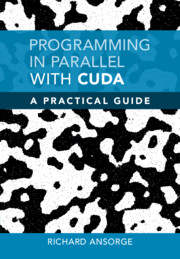Refine search
Actions for selected content:
2540 results in Computational Science
2 - The Geometry Near an Intersection
- from Part I - Theoretical Foundations
-
- Book:
- Geometry of the Phase Retrieval Problem
- Published online:
- 21 April 2022
- Print publication:
- 05 May 2022, pp 39-64
-
- Chapter
- Export citation
Frontmatter
-
- Book:
- Data-Driven Science and Engineering
- Published online:
- 10 June 2022
- Print publication:
- 05 May 2022, pp i-iv
-
- Chapter
- Export citation
9 - Phase Retrieval with the Nonnegativity Constraint
- from Part II - Analysis of Algorithms for Phase Retrieval
-
- Book:
- Geometry of the Phase Retrieval Problem
- Published online:
- 21 April 2022
- Print publication:
- 05 May 2022, pp 191-204
-
- Chapter
- Export citation
6 - Introduction to Part II
- from Part II - Analysis of Algorithms for Phase Retrieval
-
- Book:
- Geometry of the Phase Retrieval Problem
- Published online:
- 21 April 2022
- Print publication:
- 05 May 2022, pp 109-114
-
- Chapter
- Export citation

Programming in Parallel with CUDA
- A Practical Guide
-
- Published online:
- 04 May 2022
- Print publication:
- 02 June 2022
Preface
-
- Book:
- Mathematical Pictures at a Data Science Exhibition
- Published online:
- 21 April 2022
- Print publication:
- 28 April 2022, pp xiii-xvi
-
- Chapter
- Export citation
18 - Group Testing
- from Part Three - Compressive Sensing
-
- Book:
- Mathematical Pictures at a Data Science Exhibition
- Published online:
- 21 April 2022
- Print publication:
- 28 April 2022, pp 149-156
-
- Chapter
- Export citation
Executive Summary
- from Part Two - Optimal Recovery
-
- Book:
- Mathematical Pictures at a Data Science Exhibition
- Published online:
- 21 April 2022
- Print publication:
- 28 April 2022, pp 67-67
-
- Chapter
- Export citation
13 - Quasi-Monte Carlo Integration
- from Part Two - Optimal Recovery
-
- Book:
- Mathematical Pictures at a Data Science Exhibition
- Published online:
- 21 April 2022
- Print publication:
- 28 April 2022, pp 102-112
-
- Chapter
- Export citation
Appendix B - Probability Theory
- from Appendices
-
- Book:
- Mathematical Pictures at a Data Science Exhibition
- Published online:
- 21 April 2022
- Print publication:
- 28 April 2022, pp 259-273
-
- Chapter
- Export citation
8 - Dimension Reduction
- from Part One - Machine Learning
-
- Book:
- Mathematical Pictures at a Data Science Exhibition
- Published online:
- 21 April 2022
- Print publication:
- 28 April 2022, pp 56-64
-
- Chapter
- Export citation
4 - Support Vector Machines
- from Part One - Machine Learning
-
- Book:
- Mathematical Pictures at a Data Science Exhibition
- Published online:
- 21 April 2022
- Print publication:
- 28 April 2022, pp 23-30
-
- Chapter
- Export citation
26 - Various Advantages of Depth
- from Part Five - Neural Networks
-
- Book:
- Mathematical Pictures at a Data Science Exhibition
- Published online:
- 21 April 2022
- Print publication:
- 28 April 2022, pp 226-238
-
- Chapter
- Export citation
Part Three - Compressive Sensing
-
- Book:
- Mathematical Pictures at a Data Science Exhibition
- Published online:
- 21 April 2022
- Print publication:
- 28 April 2022, pp 113-114
-
- Chapter
- Export citation
Executive Summary
- from Part One - Machine Learning
-
- Book:
- Mathematical Pictures at a Data Science Exhibition
- Published online:
- 21 April 2022
- Print publication:
- 28 April 2022, pp 3-3
-
- Chapter
- Export citation
Executive Summary
- from Part Four - Optimization
-
- Book:
- Mathematical Pictures at a Data Science Exhibition
- Published online:
- 21 April 2022
- Print publication:
- 28 April 2022, pp 159-159
-
- Chapter
- Export citation
7 - Clustering
- from Part One - Machine Learning
-
- Book:
- Mathematical Pictures at a Data Science Exhibition
- Published online:
- 21 April 2022
- Print publication:
- 28 April 2022, pp 47-55
-
- Chapter
- Export citation
24 - First Encounter with ReLU Networks
- from Part Five - Neural Networks
-
- Book:
- Mathematical Pictures at a Data Science Exhibition
- Published online:
- 21 April 2022
- Print publication:
- 28 April 2022, pp 208-215
-
- Chapter
- Export citation
Contents
-
- Book:
- Mathematical Pictures at a Data Science Exhibition
- Published online:
- 21 April 2022
- Print publication:
- 28 April 2022, pp vii-xii
-
- Chapter
- Export citation
27 - Tidbits on Neural Network Training
- from Part Five - Neural Networks
-
- Book:
- Mathematical Pictures at a Data Science Exhibition
- Published online:
- 21 April 2022
- Print publication:
- 28 April 2022, pp 239-246
-
- Chapter
- Export citation
